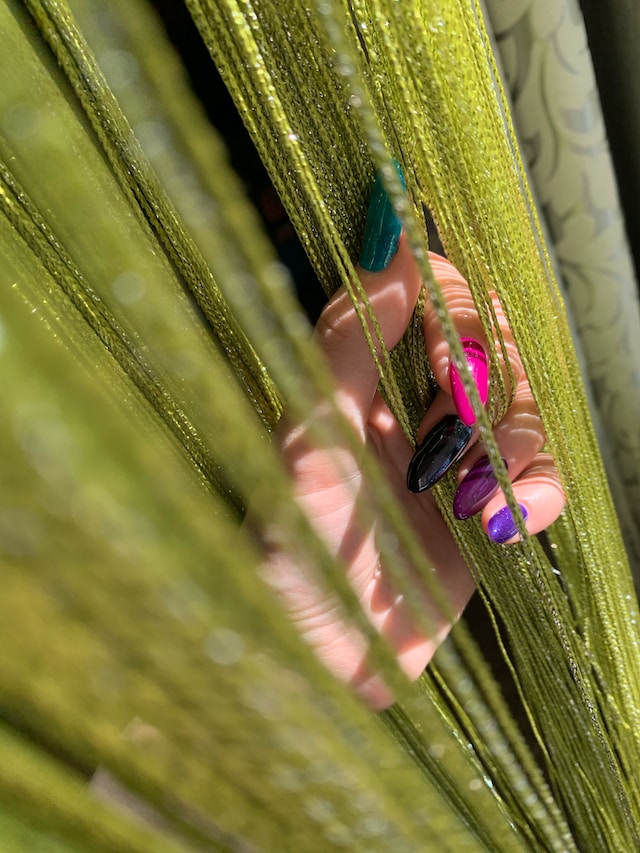Fiberglass nails are awesome and popular, but when it comes the time to remove them, it can be a little scary if you’ve never done it before. You don’t want to mess up your natural nails, but you still want to take the extensions off properly.
In this blog post, I’m going to show you step-by-step how to remove fiberglass nails without any damage to your natural nails.

Fiberglass nails overview
Fiberglass nails are a type of artificial nail enhancement.
They are created using a combination of fiberglass and a resin adhesive.
The fiberglass material is thin and lightweight.
So this type of nail extensions is a popular choice for people who prefer a thin and natural look for their artificial nails.
During the application process, the fiberglass material is layered on top of the natural nail bed.
And then it’s secured using the resin adhesive.
Once the adhesive has dried, the fiberglass material is then shaped and buffed to create a smooth, even surface.
Many people prefer fiberglass nails over acrylic or gel nails due to their superior flexibility.
They can also be removed in the same way as acrylic nails.
So they are a good option for those who are used to acrylics and gel nail polishes.
Why you should remove fiberglass nails on time
Fiberglass nails as any artificial nail enhancement require removal after a certain period of time.
Usually it’s 2–3 weeks.
There are several reasons why it’s important not to wear fiberglass nails for too long, including:
1. Natural nail health
Wearing artificial nails for too long can cause damage to the natural nail bed.
That may force you to take a long break before you can apply nail enhancements again.
Removing fiberglass nails on time allows your natural nails to recover from the stress of wearing the same artificial nails.
2. Nail growth
Removing fiberglass nails can help promote natural nail growth.
Fake nails may hinder the growth process if left on for too long.
3. Hygiene
Over time, bacteria and fungi can build up underneath the artificial nail.
This leads to nail infections.
Removing fiberglass nails regularly is more hygienic.
And it helps to prevent contamination.
4. Aesthetics
As the nail grows, the gap between the natural nail and the artificial nail will become more noticeable.
So your manicure will look uneven and not very pretty.
Removing fiberglass nails creates a clean canvas to apply new nail enhancements.
How to remove fiberglass nails
Tools and supplies you’ll need
Here’s a closer look at all the essential tools and supplies that you’ll need:
1. Coarse Nail File
A coarse nail file is necessary for buffing the surface of the fiberglass nail.
This is necessary for removing as much of the material as possible without damaging the natural nail.
A 100-180 grit nail file works best for this step.
2. Acetone nail polish remover
Acetone is a strong solvent used in nail polish removers.
It effectively breaks down the adhesive that holds the fiberglass material in place.
Acetone is also used for soaking off gel nail polish and acrylic nails.
3. Cotton balls
You’ll need to soak cotton balls in acetone nail polish remover and apply them to the fiberglass nail.
4. Aluminum foil
Aluminum foil is wrapped around the fingertip to keep the acetone-soaked cotton ball in place during the soaking process.
5. Cuticle pusher
A cuticle pusher is a small tool with a flat end that.
Use it to gently push the remaining softened fiberglass material off the natural nail.
6. Buffer
A buffer is a small, square block with different levels of abrasiveness on each side.
Use the buffer to smooth out the surface of the natural nail after all the fiberglass material has been removed.
Having all the right tools before removing fiberglass nails will make your life so much easier.
Plus, you’ll get the job done quickly and safely.
How to remove fiberglass nails at home step-by-step
Here is a step-by-step guide on how to remove fiberglass nails:
- Use a coarse nail file to buff the surface of the fiberglass nail.
- Buff until as much of the material has been removed as possible without damaging the natural nail underneath.
- Soak a cotton ball in acetone, then place it onto the fiberglass nail.
- Wrap the fingertip in a piece of aluminum foil to secure the cotton ball in place.
- Leave the cotton ball on for approximately 10–15 minutes. This will allow the acetone to break down the adhesive holding the fiberglass material in place.
- Remove the aluminum foil and cotton ball.
- Use a cuticle pusher to gently push any remaining fiberglass material off the natural nail.
- Buff the surface of the natural nail with a buffer to smooth out any rough edges or leftover residue.
- Once all the fiberglass material is removed, wash your hands thoroughly with soap and water to remove any remaining acetone or fiberglass debris.
Avoid forcefully pulling or ripping the fiberglass material off the natural nail.
This can damage the nail bed and cause pain.
Rushing through the process can actually harm your nails and leave them weaker in the long run.
So take your time and be gentle to keep your nails healthy and strong.
Can I remove fiberglass nails at home, or should I go to a salon?
Sure, you can remove them at home following this guide.
Just use the proper tools and techniques to avoid damaging your natural nails.
How long does it take to remove fiberglass nails?
The process of removing these extensions can take about 15–30 minutes.
That’s because you’ll need to soak them off for about 10–15 minutes.
Is it painful to remove fiberglass nails?
No, it’s a safe and easy at-home method.
When done correctly, this process should not be painful.
However, if you experience any discomfort or pain, stop immediately and consult a professional.
Can I reuse the fiberglass material?
No, unlike, for example, press-on nails, fiberglass material gets irreparably damaged during the removal process.
So it’s not reusable.
How often should I remove and replace my fiberglass nails?
Fiberglass nails should be replaced every two to three weeks to maintain hygiene, health, and strength of your natural nails.
Can I use a different type of remover instead of acetone?
Acetone is the most effective remover for fiberglass nails.
Non-acetone polish remover is not strong enough to dissolve the adhesive.
Can I soak my fingers in a bowl of acetone instead of using cotton balls and aluminum foil?
No, never do that!
While soaking your fingers in acetone for speeding up the process can be tempting, it can also dry out your skin and nails.
So always use cotton balls and aluminum foil to only apply a small amount of acetone to your nails.
So if you want to remove fiberglass nails at home, don’t worry.
It’s totally doable!
It just takes a little patience, care, and the right tools and techniques.
Follow the steps outlined in this guide.
With some practice and these tips, you’ll be a pro at doing it in no time.












